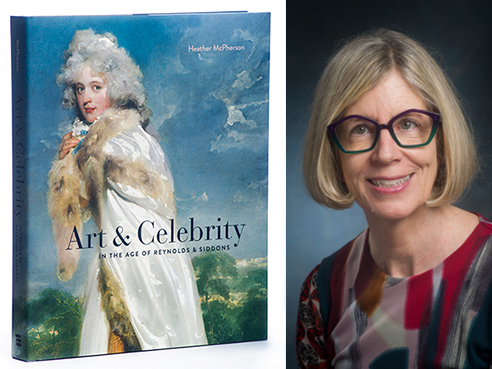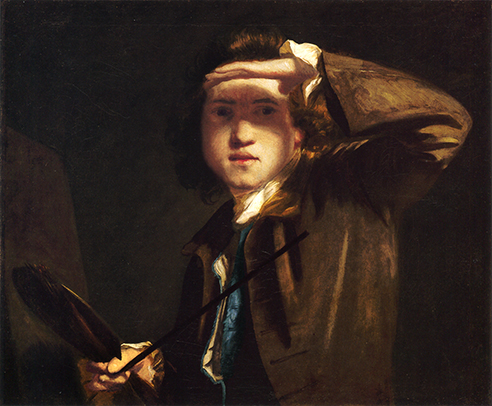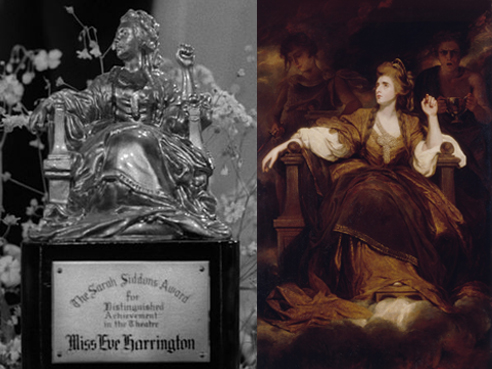 Heather McPherson, Ph.D., professor in the Department of Art and Art History, recently published “Art and Celebrity in the Age of Reynolds and Siddons.”In 2017, the world of Brad Pitt, the Kardashians and YouTube stars who become overnight sensations, a culture of celebrity is the norm. But the kind of attention afforded to celebrities today is a relatively new concept — one that began to form in the 18th century, when portraiture, theater, the visual arts and mass printing converged to form the appetite for what we now think of as celebrity culture, said Heather McPherson, Ph.D., professor in the Department of Art and Art History.
Heather McPherson, Ph.D., professor in the Department of Art and Art History, recently published “Art and Celebrity in the Age of Reynolds and Siddons.”In 2017, the world of Brad Pitt, the Kardashians and YouTube stars who become overnight sensations, a culture of celebrity is the norm. But the kind of attention afforded to celebrities today is a relatively new concept — one that began to form in the 18th century, when portraiture, theater, the visual arts and mass printing converged to form the appetite for what we now think of as celebrity culture, said Heather McPherson, Ph.D., professor in the Department of Art and Art History.
In her latest book “Art and Celebrity in the Age of Reynolds and Siddons,” McPherson explores public affection for 18th-century performers such as English actress Sarah Siddons — known for roles such as Lady Macbeth in “Macbeth” and Queen Katherine in “Henry VIII”— and the role of renowned portraitists such as Sir Joshua Reynolds, first president of the Royal Academy of Arts in London, in making them phenomena.
“I was interested in looking at the intersection of portraiture and the theater and the central role of the visual and performing arts in fueling the notion of celebrities being public personalities that people identify with and are invested in,” McPherson said.
A growing public interest in art and entertainment was fostered in part by the growth of the theater as a widely popular art form in 18th-century London, McPherson said.
“We tend to think of the theater as something elitist,” McPherson said. “But in the 18th century, everyone went to the theater — servants, writers, aristocrats — and it became a really important platform for actors and actresses to become brands. Before that, it tended to be more about repertoire or dramatic tradition rather than a star vehicle.”
 Sir Joshua Reynolds painted this self-portrait of himself at 24.Standing out
Sir Joshua Reynolds painted this self-portrait of himself at 24.Standing out
As more people flocked to the theater for entertainment, the popularities of performers skyrocketed, and portraitists such as Reynolds sought to capture the performers as themselves, posing in the studio wearing fine clothes, and also as the characters they embodied during a particular theater performance.
“You have a portrait of an actor or actress playing a particular role. It’s an art form that really develops in this period and becomes popular,” McPherson said.
That popularity was bolstered by inclusion of those portraits in exhibitions at the Royal Academy of Arts, where artists and creatives would view and debate works, McPherson said, because there was already a budding sense of celebrity around the subjects.
“It was a win/win for both the subject as well as the artist,” she said. “Paintings covered the walls like postage stamps, so you wanted to stand out. To do that, you’d create dramatic portraits [of actors].”
New connections
As the theater and the Academy grew in popularity, technological advances such as newspapers, a developing interest in biography and autobiography and the dissemination of images, specifically prints, influenced how people connected with their celebrities, McPherson said.
|
“We tend to think of the theater as something elitist. But in the 18th century, everyone went to the theater — servants, writers, aristocrats — and it became a really important platform for actors and actresses to become brands.” |
Also popular was the use of parody or caricature of contemporary celebrities to make social or political statements, McPherson said, much like the modern era. While celebrities often were considered influential in entertainment, culture and style, the public also could easily abandon them after one bad performance or personal scandal, she said.
“Caricature was emerging as a major art form, but you had to be famous enough that, if you were caricatured, people would know who it is and get it,” McPherson said. “They were a mark of celebrity, but widely praised celebrities also were targeted by them.”
Fluidity in art
 The classic 1950 film “All About Eve” opens with a scene of a ceremony in which the titular Eve Harrington receives the fictitious Sarah Siddons Award (left), modeled after Sir Joshua Reynold’s famous portrait of the actress, which depicts her as the classical muse Melpomene.
The classic 1950 film “All About Eve” opens with a scene of a ceremony in which the titular Eve Harrington receives the fictitious Sarah Siddons Award (left), modeled after Sir Joshua Reynold’s famous portrait of the actress, which depicts her as the classical muse Melpomene.
Even the way popular actors at the time interacted with art could affect the way the work was understood or received, McPherson said. In 1771, English actor David Garrick, who revolutionized acting by using a more natural and expressive style of performance, took exception with Benjamin West’s historical painting “The Death of General Wolfe” on exhibit at the Academy. A portrayal of the death of British General James Wolfe at the 1759 Battle of Quebec during the French and Indian War, the painting — specifically Wolfe’s expression — was criticized by Academy visitors as too dramatic.
The story goes that Garrick actually recreated the pose right there in the exhibition space and modified the expression to what he believed would have been a more suitable heroic expression,” McPherson said. “It was fascinating that you’d have an actor recreating a painting.”
Such fluid interactions between two facets of 18th-century art — painting and the theater —inspired McPherson to write “Art and Celebrity in the Age of Reynolds and Siddons.” The book details the growing availability of reprints of portraits and artwork and explores changing artistic and cultural norms in the 18th century that ultimately transform the ways modern celebrities are viewed.
I think about all these kinds of images, from beautiful painted portraits to popular prints to caricatures, as something that brought the public closer to these figures,” McPherson said. “If you have a print of a celebrity, it’s almost like you own them in a way, like you have a personal relationship with them, and that’s what I saw developing in this time period.”|
“If you have a print of a celebrity, it’s almost like you own them in a way, like you have a personal relationship with them, and that’s what I saw developing in this time period.” |
McPherson teaches honors seminars at UAB on the phenomenon of art and celebrity, ranging from the ancient world to the 20th century and in portraiture. In her class on 18th-century art and culture, she encourages students to work with original artwork from the Birmingham Museum of Art, which she said has a comprehensive selection.
Her next book project will focus on 19th-century French painters and the centrality of their studios to the artist’s professional identity and practice.
